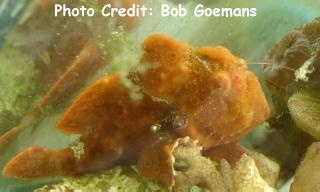
By Bob Goemans

Not Reef Tank Suitable
Likely Fish-Only Tank Suitable
Range: Indo-West Pacific Ocean: Southern Africa and the Red Sea, and Tropical Western Pacific from Lord Howe Island north to Southern Japan.
Size: 12 inches (30 cm)
Natural Environment: Inhabits hard substrates on shallow fringing reefs and gently sloped areas from depths of 3 – 150 feet (1 – 45 m) and often found in association with sponges, adopting their color for camouflage where it it mainly feeds on small fishes and crustaceans. Occurs singly, in pairs, or in trios.
General Husbandry: Rarely seen in the trade, and one of the more colorful frogfish. Will sometimes assume the color of the object it is near to enhance its camouflage. Equipped with an angling lure that dangles an enticing looking object near its mouth.
Best maintained in fish-only aquariums with tankmates too large to be eaten, or possibly a single species aquarium, with some decor, such as live rocks, that will give the species the feeling of being secure while waiting dinner.
As to diet, keep in mind these fish are carnivores, and require a diet high in protein and amino acids (lipids/fats). Products such as live marine fish and/or marine fish and crustacean flesh, clams, and other marine meaty foods should make up the majority of their diet. Non-living foodstuffs can be suspended/impaled on a long thin stick and dangled within range to entice feeding.
However, ‘occasional’ live mollies, guppies, goldfish, and/or Gambusia provide for that natural feeding excitement found in the wild should live marine fish not be available. Nevertheless, feeding these small freshwater live fish should be considered a special treat and not become a steady diet since they lack the fatty acids that marine fish need to stay healthy.
Keep in mind that feeder goldfish, which cannot survive but a few minutes in seawater, also carry many different bacteria, fungi, and protozoa that can cause parasitic and infectious diseases. Furthermore, feeder goldfish can also cause blockage in the digestive track and/or kidney along with liver damage due to fatty degeneration in the consuming fish. And this will ultimately lead to the consumer’s death. In fact, fatty liver degeneration is a common cause of death in cases where marine fish are fed a diet that primarily consists of goldfish (as with Lionfish for example). Also, its possible the large air bladder in the goldfish can upset the internal balance in this fish, sometimes causing it to float at the surface, possibly killing it.
For those aquarists living near the coastline there are often fisherman bait shops that sell small live marine fish that can be used as bait. If available, these small live marine baitfish are an excellent foodstuff.
Because these are sedentary fish, their metabolism is quite low. Therefore infrequent feedings of once or twice a week for adults and three or four times a week for juveniles is recommended.
This species, which is one of the more commonly seen in the trade, is one of the largest frogfish and should be maintained in an aquarium no smaller than 100 gallons and of course without eatable tankmates. At least those you want to keep! Juveniles, such as in the photo, should be kept in small aquaria where their needs can be better attended to until they outgrow their quarters. They are susceptible to Amyloodinium and Cryptocaryon, therefore prevent sudden temperature changes and/or other stressful conditions, as this opens a window of opportunity for these maladies.
Taxonomy:
Order: Lophiiformes
Suborder: Antennarioidei
Family: Antennariidae
Subfamily: Antennariinae
Genus: Antennarius
FYI: Capable of changing colors to match surroundings.
Poor choice for reef aquariums, as it would stay hidden most of the time.
Will consume ornamental crustaceans.
Best maintained in its own private environment.
Lacks a swim bladder, that's why they are bottom dwelling fishes.
Lacks teeth, swallows prey whole.
Experience Level: Intermediate
Temperament: Semi-aggressive
Diet: Carnivore
Coral Safe: Yes
Fish Safe: With caution
Invertebrate Safe: With caution
Acclimation Time: 30 minutes+
Aquarium Environment: Fish-only aquarium
Tankmates: Peaceful, yet large enough not to be eaten
Minimum Tank Size: 100+ gallons
Temperature Range: 72 - 80°F (22 – 27°C)
Specific Gravity: 1.020 - 1.026
pH: 8.0 - 8.5
